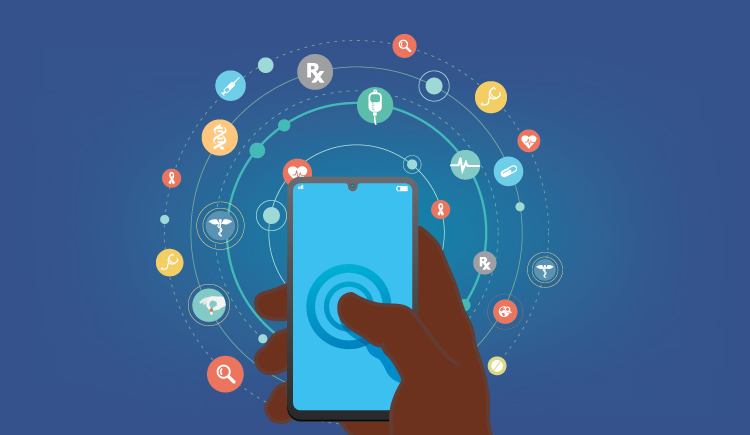Global health goals are big, set by the United Nations (UN) Sustainable Development Goals (SDGs). We need new ways to meet these goals, and digital technology is key. Digital solutions can make a big difference in low- and middle-income countries (LMICs). They help by speeding up progress, reaching more people, and making care better and more efficient.
Digital health is all about using tech to improve health. It includes mobile health (mHealth), health information technology (IT), health information systems, wearable devices, telehealth, and telemedicine.
Key Takeaways
- Digital solutions can accelerate progress in improving global health outcomes.
- Digital health encompasses a wide range of technologies, including mHealth, health IT, wearables, and telehealth.
- Digital health can increase speed, reach, and access to healthcare, especially in low- and middle-income countries.
- Digital health can improve the quality of care and reduce inefficiencies in healthcare systems.
- Leveraging digital health is crucial for meeting the ambitious targets of the UN Sustainable Development Goals.
The Transformative Power of Digital Health
The digital health transformation could change global healthcare, especially in low- and middle-income countries (LMICs). Digital technologies offer speed, reach, and access. This can lead to better health outcomes and help patients and providers a lot.
Speed, Reach, and Access
Digital health solutions can speed up progress in LMICs. They give faster access to vital healthcare services and info. For example, telehealth and mHealth apps connect patients with doctors from afar. This cuts down on the need for in-person visits and spreads specialized care wider.
Empowering Patients and Providers
Digital health tech empowers patients and providers in LMICs. Patients can manage their health better with mobile apps and wearable devices. Providers can use tools and online learning to improve their skills and knowledge.
By using digital health’s power, we can work towards universal health coverage and better health in LMICs. This helps both people and the healthcare systems that care for them.
Global Health Challenges and the Need for Innovative Solutions

Great strides have been made in improving health worldwide, but big challenges still affect low- and middle-income countries (LMICs). To meet UN Sustainable Development Goals, we need new ideas. Digital technology can help speed up progress.
Some major global health challenges need new solutions, including:
- Limited access to quality healthcare, especially in rural areas
- Inadequate disease prevention and management strategies
- Lack of reliable data and real-time monitoring
- Inefficient supply chain and resource distribution
- Shortage of skilled healthcare workers and high rates of burnout
Innovative solutions using digital health tech can tackle these issues. Tools like telemedicine, mobile health apps, data analytics, and supply chain optimization can change healthcare for the better. They make healthcare more accessible and efficient around the world.
| Challenge | Innovative Digital Health Solution |
|---|---|
| Limited access to healthcare | Telemedicine and mobile health apps for remote consultations |
| Inadequate disease prevention and management | Wearable devices and smart sensors for health monitoring |
| Lack of reliable data and real-time monitoring | Data analytics and AI tools for better surveillance and decision-making |
Using digital health, we can find new ways to tackle big health challenges. This helps us move closer to UN Sustainable Development Goals for a healthier, fairer world.
Digital Health: Definitions and Applications

Digital health combines health with information and communication technology (ICT). It includes mobile health (mHealth), health IT, and telehealth. These technologies are changing healthcare worldwide.
Key Areas of Digital Health
The main areas of digital health are:
- Delivering health info to professionals and people through the internet and phones
- Improving public health services with ICTs, like training health workers
- Using health systems to manage and share patient and facility data
Addressing Inefficiencies and Improving Care
Digital health tools are cutting down on waste, making healthcare easier to get, cheaper, and more tailored. For instance, telehealth lets doctors see patients remotely. mHealth tracks health data. Wearable devices let people take charge of their health.
Health information technology makes admin tasks easier and helps doctors make better decisions.
“Digital health technologies have the potential to transform global health by improving access, quality, and cost-effectiveness of healthcare delivery.”
As digital health grows, these new solutions will tackle big challenges and move forward in global health.
Overcoming Barriers to Digital Health Adoption in Low- and Middle-Income Countries
The digital health sector is growing fast, but many in low- and middle-income countries (LMICs) are missing out. They face a complex digital health scene. Many public and private groups work alone, causing coordination issues.
A big hurdle is the lack of standard rules for digital health tools. This makes it hard to share data and work together. LMICs also struggle with not having enough people to manage tech and use the data well.
Another big challenge is getting funding that matches government goals. It’s hard to grow promising digital health solutions without strong leadership and support. Also, finding affordable, easy-to-use, and flexible tech is tough.
Addressing the Barriers
To help LMICs use more digital health, we need a complex plan. This plan includes:
- Creating common rules and ways for different digital health projects to work together.
- Investing in training and tech skills in LMICs to use digital health tools well.
- Matching funding and policies with what governments want, for lasting and growing digital health solutions.
- Encouraging working together in regions and sharing knowledge to improve digital health projects.
- Supporting the creation and use of affordable, flexible digital health tech that fits into current health systems.
By tackling these barriers, the digital health field can really change healthcare for the better. It can bring fair, accessible healthcare to people in LMICs all over the world.
Public-Private Partnerships for Global Health

Digital health solutions are changing the way we tackle global health issues. They need the help of both public and private sectors to work well. Public-private partnerships (PPPs) bring these sectors together. They help coordinate efforts, integrate resources, and get everyone involved, leading to big improvements in global health.
Fostering Coordination and Integration
PPPs focused on digital health connect different groups in the health tech world. They make sure everyone works together and uses their resources well. By joining governments, companies, non-profits, and community groups, these partnerships can tackle complex health problems effectively.
Engaging Stakeholders and Tackling Challenges
Good PPPs need strong government leaders and clear roles for everyone involved. A strong ICT framework helps align health and tech sectors. This way, everyone can work together to solve the challenges of public-private partnerships, global health, and digital health.
PPPs that focus on digital health can bring new chances to improve access and the impact of digital health solutions worldwide.
Also Read: The Role Of Technology In Modern Hospitals – Improving Patient Care
Conclusion
The global health community sees digital technology as a game-changer. It can speed up progress towards better health, especially in poorer countries. Digital tools make health services faster, reach more people, and help both patients and doctors.
But, there are big hurdles to overcome. We face issues like not working together well and not having enough resources. To make digital health work, we need strong partnerships between public and private sectors. These partnerships should help everyone work together better and share resources.
By using technology, new ideas, and teamwork, we can keep making health care better for everyone. The future of health is tied to digital solutions. It’s time to take action now.
FAQs
Q: How does technology support research in global health?
A: Technology plays a critical role in advancing research by providing tools for data collection, analysis, and dissemination. It enables researchers to gather real-time data from diverse populations, enhancing the understanding of health disparities and informing public health strategies.
Q: What programs utilize technology to address health equity?
A: Various programs leverage technology to promote health equity, such as mobile health applications, telemedicine, and online health education platforms. These initiatives aim to reach underserved communities and provide resources that improve access to health care.
Q: How can students engage with global health initiatives through technology?
A: Students can engage in global health initiatives by participating in technology-driven programs, internships, or research projects that focus on health disparities. Many organizations offer training and resources for students to strengthen their skills in public health practice.
Q: What is the impact of technology on annual health events?
A: Technology enhances annual health events by facilitating virtual participation, improving outreach, and enabling real-time data sharing. This allows for broader engagement and collaboration among stakeholders in the global health community.
Q: How does collaboration between organizations enhance global health efforts?
A: Collaboration between organizations enhances global health efforts by pooling resources, knowledge, and technology. This collective approach strengthens the impact of programs aimed at addressing health disparities and advancing health equity.
Q: What opportunities exist for international partnerships in global health technology?
A: International partnerships in global health technology create opportunities for knowledge exchange, capacity building, and joint research initiatives. These collaborations can lead to innovative solutions for public health challenges faced by vulnerable populations.
Q: How does the global health institute utilize data to inform its mission?
A: The global health institute utilizes data to inform its mission by analyzing health trends, identifying disparities, and evaluating the effectiveness of programs. This evidence-based approach ensures that resources are dedicated to areas with the greatest need.
Q: In what ways can technology improve training for health care professionals?
A: Technology improves training for health care professionals by providing access to online courses, simulations, and interactive learning platforms. These resources enhance the skills and knowledge needed to address complex health issues in diverse populations.
Q: What role does community engagement play in advancing global health through technology?
A: Community engagement is essential for advancing global health through technology as it ensures that programs are culturally relevant and tailored to the needs of the population. Engaging communities fosters trust and encourages participation in health initiatives.
Source Links
- https://www.ncbi.nlm.nih.gov/books/NBK538094/
- https://www.who.int/health-topics/digital-health
- https://www.ncbi.nlm.nih.gov/pmc/articles/PMC10562722/